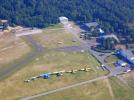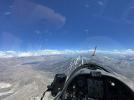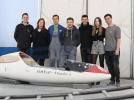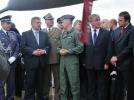Garuda A332 at Jakarta on Dec 13th 2013, touched down with right main gear off the runway
A Garuda Indonesia Airbus A330-200, registration PK-GPN performing flight GA-413 from Denpasar to Jakarta (Indonesia) with 185 passengers and 13 crew, performed an ILS approach to Jakarta's runway 25L but touched down at 15:00L (08:00Z) with the right main gear on the right runway shoulder on soft ground travelling about 500 meters before the crew steered the aircraft fully onto the runway. The aircraft rolled out without further incident and vacated the runway but needed to stop on the high speed turn off due to a hydraulic failure. There were no injuries, the aircraft sustained minor damage.
Indonesia's National Transportation Safety Committee (NTSC) released their final report concluding the probably causes of the serious incident were:
During the hand flying at approximately 90 feet AGL the aircraft started rolled in average of 2° to the right for approximately 12 seconds resulted to aircraft deviation to the right, whilst the PF loss the visual reference and prolong flare prior to touch down.
- The above condition was an indication for go around which was not executed, this might cause by insufficient pilot intuitive decision to cope such condition.
- The absence of no significant weather report might influence the pilot judgment and expectation of any weather change which may requires pilot decisions especially when occurs at low altitude.
The NTSC reported the captain (63, ATPL, 25,594 hours, 8,596 hours on type) was pilot flying, the first officer (24, CPL, 2,671 hours total, 851 hours) was pilot monitoring. ATIS announced moderate rain and thunderstorms with northwesterly winds.
During the approach while at 3000 feet MSL the crew requested to deviate right to avoid a thunderstorm cell, continued the descent to 2000 feet and re-aligned with the ILS.
While descending through 184 feet AGL the wind direction changed from westerly to southerly and the wind increased from 4 to 24 knots at touch down.
The captain disconnected the autopilot at 124 feet and continued for a manual landing. Following the 20 feet automated call out the pilot monitoring called "fly left" two times, then the automated callout "Retard" occurred for three times.
The captain later explained that just during the flare the aircraft entered heavy rain which obscured the view through the left hand windshield causing a loss of visual reference to the captain. At the same time the captain felt the aircraft was floating. The first officer reported that he could see the runway at all times and observed the aircraft was slightly right and therefore called to adjust to the left.
The aircraft received cuts to one of the right main gear tyres and a leak of the yellow hydraulic system at the right hand main gear.
The NTSC analysed that the aircraft was fully established on the localizer when the autopilot was disconnected. At about 90 feet AGL the aircraft started to roll right at about 1 degree per 3 seconds at an airspeed of 120 KIAS. Computations indicated the aircraft deviated 37.2 meters to the right, which was consistent with the localizer deviation according to the flight data recorder as well as the actual touch down mark the right main gear left on soft ground. The runway is 60 meters wide, the right main gear touched down 7 meters to the right of the runway edge.
The NTSC analysed that the first officer called "fly left" twice, the captain lost visual reference, the flight path angle changed from -3 to -1 degrees, the pitch angle increased from +2 to +7 degrees, the localizer showed a deviation of 0.52 dots, all these conditions indicated the approach was not stabilized and a go around was necessary. The Go Around was possible until after touch down until thrust reversers had been selected.
The NTSC analysed that the captain probably believed he could still safely land the aircraft and therefore continued the landing. The NTSC stated: "The PF decision to continue landing was most likely an indication that the absence of the spatial information to cope such unexpected condition had taken place either in long term memory as stated in the Airbus FCOM or in the short term memory performed in the approach briefing."
Metars:
WIII 131000Z 15005KT 6000 -RA FEW020CB SCT021 26/24 Q1007 RMK CB TO E=
WIII 130930Z 18004KT 5000 -TSRA FEW020CB SCT022 25/24 Q1007 RMK CB TO E=
WIII 130900Z VRB05KT 3000 TSRA FEW020CB BKN022 26/24 Q1007 RMK CB TO SE=
WIII 130830Z 36006KT 6000 TSRA FEW019CB SCT020 26/24 Q1006 RMK CB OVER THE FIELD=
WIII 130800Z 27010KT 4000 RA FEW020CB BKN021 27/25 Q1006 RMK CB TO E=
WIII 130730Z 33003KT 7000 -RA FEW020CB SCT023 26/24 Q1006 RETS RMK CB TO NW=
WIII 130700Z VRB03KT 5000 -TSRA FEW019CB BKN020 25/23 Q1007 RMK CB TO E=
WIII 130630Z 33008KT 5000 TSRA FEW019CB BKN020 24/22 Q1007 RMK CB TO N AND E=
WIII 130600Z 28008KT 8000 VCTS FEW020CB SCT021 32/25 Q1007 RMK CB TO NW AND E=
WIII 130530Z 27010KT 9999 SCT020 31/24 Q1007 NOSIG=
WIII 130500Z 29010KT 9999 SCT023 32/24 Q1008 NOSIG=
First touch down (Photo: NTSC):
Gear tracks along the runway (Photo: NTSC):
The hydraulic stream (Photo: NTSC):
The track of the aircraft (Graphics: NTSC):
http://avherald.com/h?article=477d8dee














Komentarze